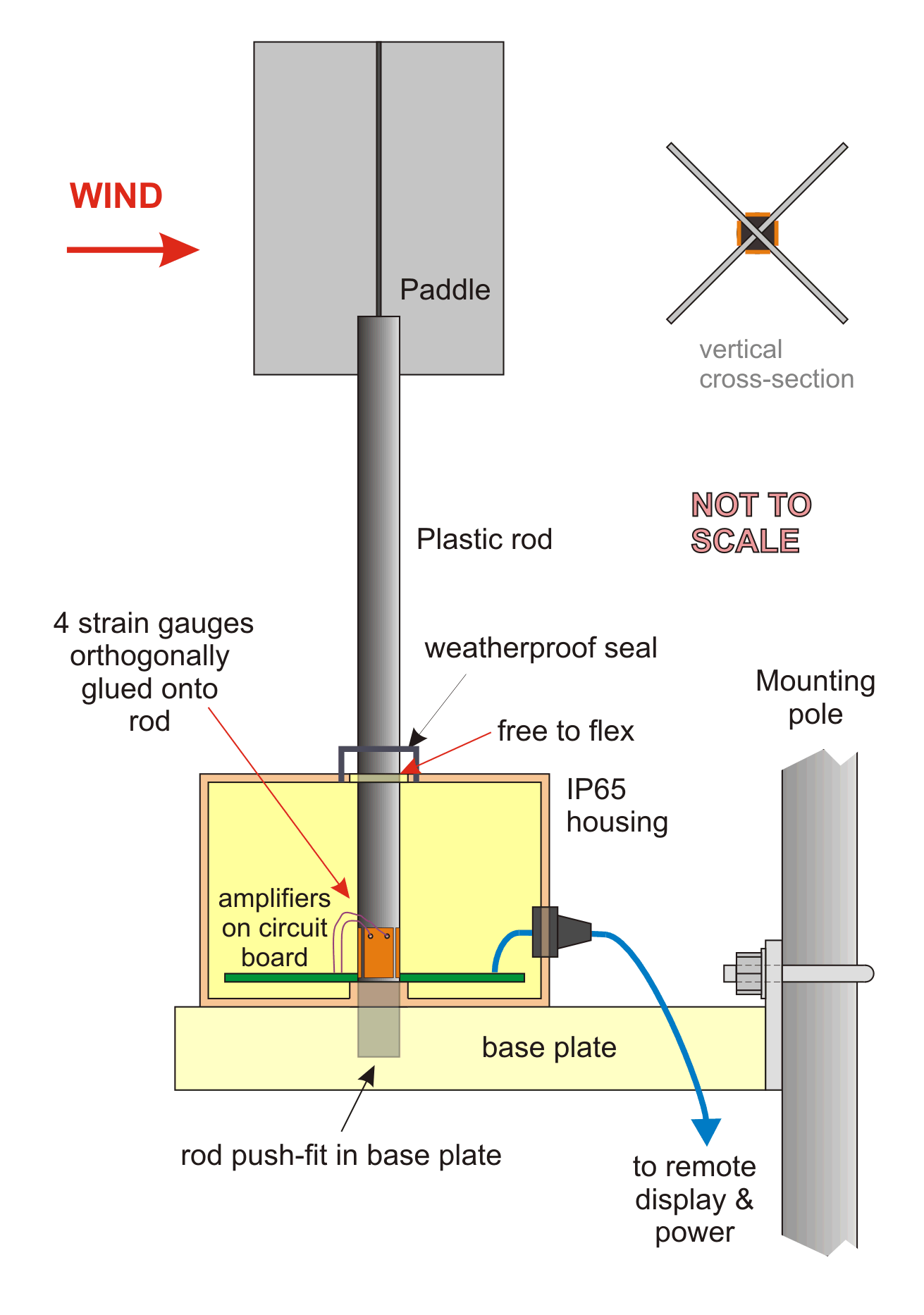Experiments
with a novel wind sensor
Tim Williams
1st
August 2025
I have been forever
interested in the weather, and have had a Davis
weather station on the roof for many years. So many, in fact, that
it’s starting to need more and more maintenance. But also I have
felt that with a bit of spare time I could build a weather station
myself, and I’ve had an idea for a no-moving-parts wind sensor
kicking around for a while. Now, with the time to spare, I’ve been
developing the idea into a working model. This page briefly describes
the design and the issues it has raised; a much longer description,
for those who want more of the nuts, bolts, and bits and pieces of
plastic can be found here:
Experience
with a novel no-moving-parts anemometer
In essence although
the unit as built does indeed measure the wind direction and speed,
it’s not really a viable alternative to the traditional
cup-and-vane anemometer or the higher-tech
ultrasonic type. It has certain characteristics which would
probably make it inadequate for any commercial realisation.
The principle
A vertical rod, fixed at the base, has four strain gauges placed
orthogonally around its circumference near to the base. At the top is
fixed an omnidirectional “sail” or “paddle”. When the wind
blows on the paddle, the rod bends and the strain is measured on the
gauges, digitised and converted from an X-Y (North-South / East-West)
pair of values to polar coordinates and displayed on a compass rose
graph. Simple, eh?
vertical rod, fixed at the base, has four strain gauges placed
orthogonally around its circumference near to the base. At the top is
fixed an omnidirectional “sail” or “paddle”. When the wind
blows on the paddle, the rod bends and the strain is measured on the
gauges, digitised and converted from an X-Y (North-South / East-West)
pair of values to polar coordinates and displayed on a compass rose
graph. Simple, eh?
I was quite
surprised that such a fairly obvious technique didn’t appear to be
commercially available as an alternative to the other types of
anemometer. With no moving parts except the bending rod, it should be
low maintenance and not particularly expensive to make. But building
and running a couple of prototypes has shown that it’s not such an
attractive idea as it seems.
The practice
There are two
particular issues that show up when trying out the design. Firstly,
because the maths shows that the strain at the base of the rod is
proportional to the square root of windspeed, the reported value is
at its most sensitive at low windspeeds or nil wind. Therefore, any
drift or error is most noticeable in calm conditions; it’s almost
impossible to see a consistent reading of 0mph. This is in contrast
to the conventional cup anemometer where the cups simply don’t
rotate when it’s calm. It’s necessary to temperature compensate
the strain gauge output even though each pair can be well matched.
Gross errors due to temperature variations can be compensated out,
but even small errors from imperfect compensation are quite obvious.
The second problem
is related to the flexing of the rod. If it’s flexible enough to
give a reasonable degree of strain at the base – the prototype used
8mm dia PVC – then the mass of the paddle combined with the length
of the rod causes the assembly to oscillate when the wind blows,
rather than bend steadily in a fixed direction. A stiffer rod would
oscillate less but also would give less deflection at the base. The
oscillation means that a sensible reading can only be taken from an
average of many individual measurements, over a longer period than
the oscillation period. The prototype takes 32 readings over 2
seconds. Even then, because the rod oscillates partly from side to
side, not just in the actual wind direction, the resultant display
tends to be quite widely distributed around the actual direction.
Conclusions
For these reasons,
and others such as the need for careful installation (to ensure the
rod is vertical and the paddle is undamaged, as well as the need to
provide for frequent zero re-calibration) it’s not really possible
to say that this design is suitable for commercial development.
Although the direction indication, when compared with a simple wind
vane mounted close nearby, is somewhat “scattered” to put it
kindly, the peak and average recorded windspeeds do agree pretty
closely with the cup anemometer also mounted nearby.
After all this
effort, I’ll keep the prototype running for a while to see what the
long term reliability might be like. But the market dominance of the
cup-and-vane and ultrasonic types doesn’t look like being
challenged just yet.
 vertical rod, fixed at the base, has four strain gauges placed
orthogonally around its circumference near to the base. At the top is
fixed an omnidirectional “sail” or “paddle”. When the wind
blows on the paddle, the rod bends and the strain is measured on the
gauges, digitised and converted from an X-Y (North-South / East-West)
pair of values to polar coordinates and displayed on a compass rose
graph. Simple, eh?
vertical rod, fixed at the base, has four strain gauges placed
orthogonally around its circumference near to the base. At the top is
fixed an omnidirectional “sail” or “paddle”. When the wind
blows on the paddle, the rod bends and the strain is measured on the
gauges, digitised and converted from an X-Y (North-South / East-West)
pair of values to polar coordinates and displayed on a compass rose
graph. Simple, eh?